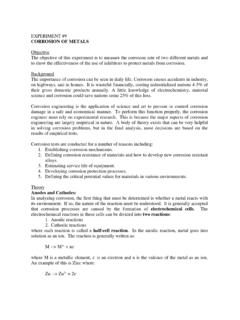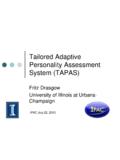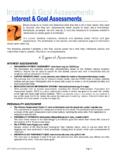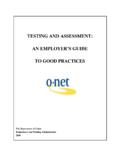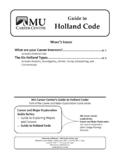Transcription of CHAPTER Classification and Assessment of …
1 28-09-2007 14:34 Page 68. 3. Classification and Assessment of Abnormal Behavior CHAPTER . CHAPTER OUTLINE. HOW ARE ABNORMAL BEHAVIOR PATTERNS METHODS OF Assessment 80 99 Cognitive Assessment CLASSIFIED? 70 77 The Clinical Interview Physiological Measurement The DSM and Models of Abnormal Behavior Computerized Interviews SOCIOCULTURAL AND ETHNIC FACTORS. STANDARDS OF Assessment 77 80 Psychological Tests IN Assessment 99 100. Neuropsychological Assessment Reliability SUMMING UP 100 101. Behavioral Assessment Validity 28-09-2007 14:34 Page 69. T R U T H or F I C T I O N.
2 T F Some men in India have a psycho- Jerry Has a Panic Attack on the logical disorder characterized by anxiety over Interstate losing semen. (p. 74). T F Although it is not an exact science, Interviewer: Can you tell me a bit about what it was that brought you to the clinic? the measurement of the bumps on a person's Jerry: Well, .. after the first of the year, I started getting these panic attacks. head can be used to determine the person's I didn't know what the panic attack was. personality traits. (p. 80). Interviewer: Well, what was it that you experienced?
3 T F An objective test of personality is Jerry: Uhm, the heart beating, racing .. one that does not require any subjective Interviewer: Your heart started to race on you. judgments on the part of the person taking Jerry: And then uh, I couldn't be in one place, maybe a movie, or a church .. the test. (p. 84). things would be closing in on me and I'd have to get up and leave. Interviewer: The first time that it happened to you, can you remember that? T F One of the most widely used Jerry: Uhm, yeah I was .. personality tests asks people to interpret what they see in a series of inkblots.
4 (p. 88). Interviewer: Take me through that, what you experienced. Jerry: I was driving on an interstate and, oh I might've been on maybe 10 or T F People in weight-loss programs who 15 minutes. carefully monitor what they eat tend to lose Interviewer: Uh huh. less weight than people who are less-reliable Jerry: All of a sudden I got this fear. I started to .. uh race. monitors. (p. 94). Interviewer: So you noticed you were frightened? T F Despite advances in technology, Jerry: Yes. physicians today must still perform surgery to Interviewer: Your heart was racing and you were perspiring.
5 What else? study the workings of the brain. (p. 96). Jerry: Perspiring and uh, I was afraid of driving anymore on that interstate for T F Cocaine cravings in people addicted the fear that I would either pull into a car head on, so uhm, I just, I just to cocaine have been linked to parts of the couldn't function. I just couldn't drive. brain that are normally activated during Interviewer: What did you do? pleasant emotions. (p. 99). Jerry: I pulled, uh well at the nearest exit. I just got off .. uh stopped and, I had never experienced anything like that before.
6 Interviewer: That was just a .. Jerry: Out of the clear blue .. Interviewer: Out of the clear blue? And what'd you think was going on? Jerry: I had no idea. Interviewer: You just knew you were .. Jerry: I thought maybe I was having a heart attack. Interviewer: Okay. Source: Exerpted from Panic Disorder: The Case of Jerry, found on the Videos in Abnormal Psychology CD-ROM that accompanies this textbook. JERRY BEGINS TO TELL HIS STORY, GUIDED BY THE INTERVIEWER. PSYCHOLOGISTS AND OTHER. mental health professionals use clinical interviews and a variety of other means to assess abnormal behavior, including psychological testing, behavioral Assessment , and physiological monitoring.
7 The clinical interview is an important way of assessing abnormal behavior and arriving at a diagnostic impression in this case, panic disor- der. The clinician matches the presenting problems and associated features with a set of diagnostic criteria in forming a diagnostic impression. The diagnosis of psychological or mental disorders represents a way of classifying patterns of abnormal behavior on the basis of their common features or symptoms. Abnormal behavior has been classified since ancient times. Hippocrates classified abnormal behaviors according to his theory of humors (vital bodily fluids).
8 Although his theory proved to be flawed, Hippocrates' Classification of some types of mental health problems generally correspond to diagnostic categories we use today. His descrip- tion of melancholia, for example, is similar to our current conception of depression. 69. 28-09-2007 14:34 Page 70. 70 CHAPTER 3. During the Middle Ages some authorities classified abnormal behaviors into two groups, those that resulted from demonic possession and those due to natural causes. The 19th-century German psychiatrist Emil Kraepelin was the first modern theorist to develop a comprehensive model of Classification based on the distinctive features, or symptoms, associated with abnormal behavior patterns (see CHAPTER 1).
9 The most commonly used Classification system today is largely an outgrowth and extension of Kraepelin's work: the Diagnostic and Statistical Manual of Mental Disorders (DSM), published by the American Psychiatric Association. Why is it important to classify abnormal behavior? For one thing, Classification is the core of science. Without labeling and organizing patterns of abnormal behavior, researchers could not communicate their findings to one another, and progress toward understanding these disorders would come to a halt. Moreover, important decisions are made on the basis of Classification .
10 Certain psychological disorders respond better to one therapy than another or to one drug than another. Classification also helps clinicians pre- dict behavior: schizophrenia, for example, follows a more or less predictable course. Finally, Classification helps researchers identify populations with similar patterns of abnormal behavior. By classifying groups of people as depressed, for example, researchers might be able to identify common factors that help explain the origins of depression. This CHAPTER reviews the Classification and Assessment of abnormal behavior, begin- ning with the DSM.









